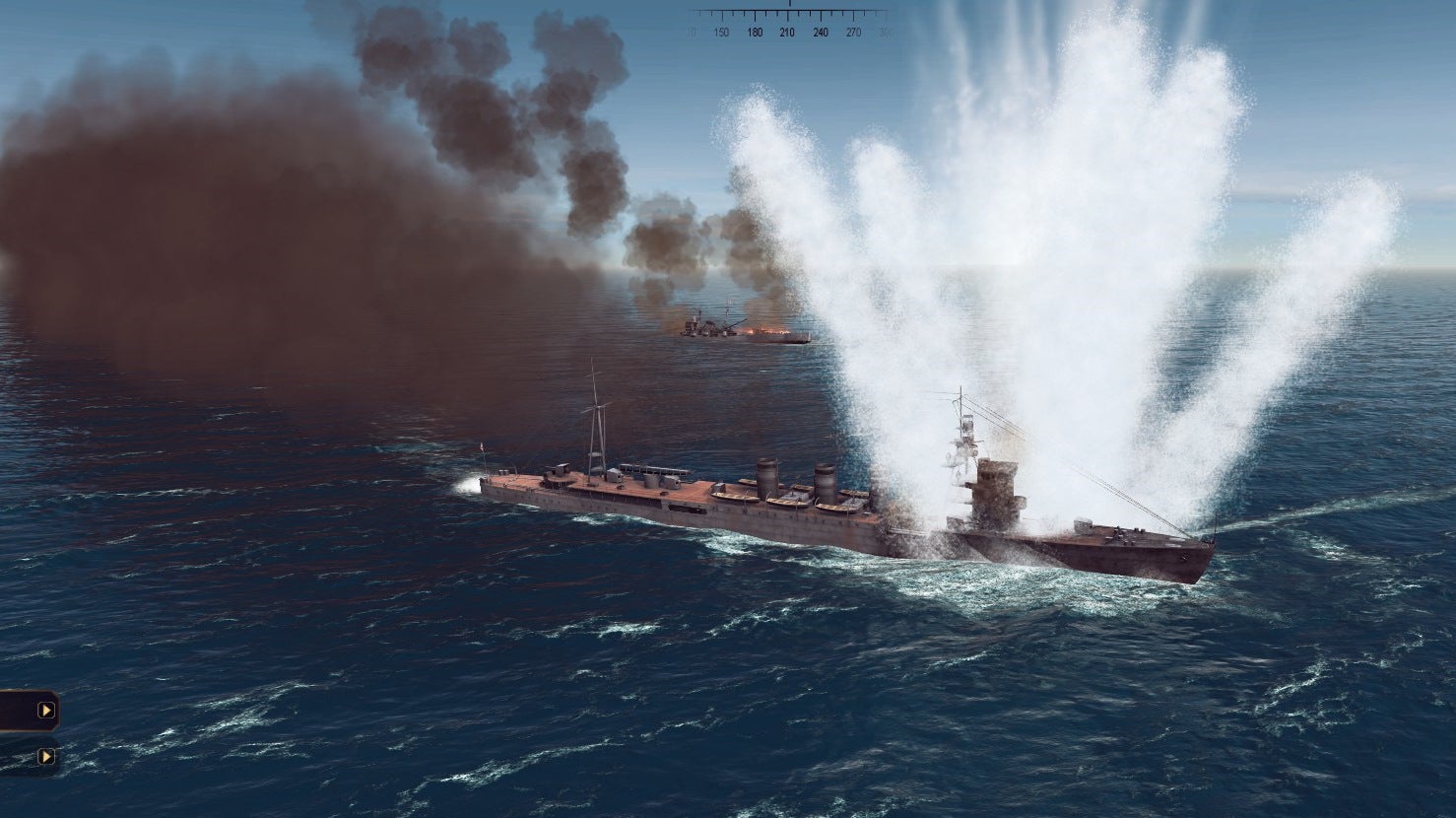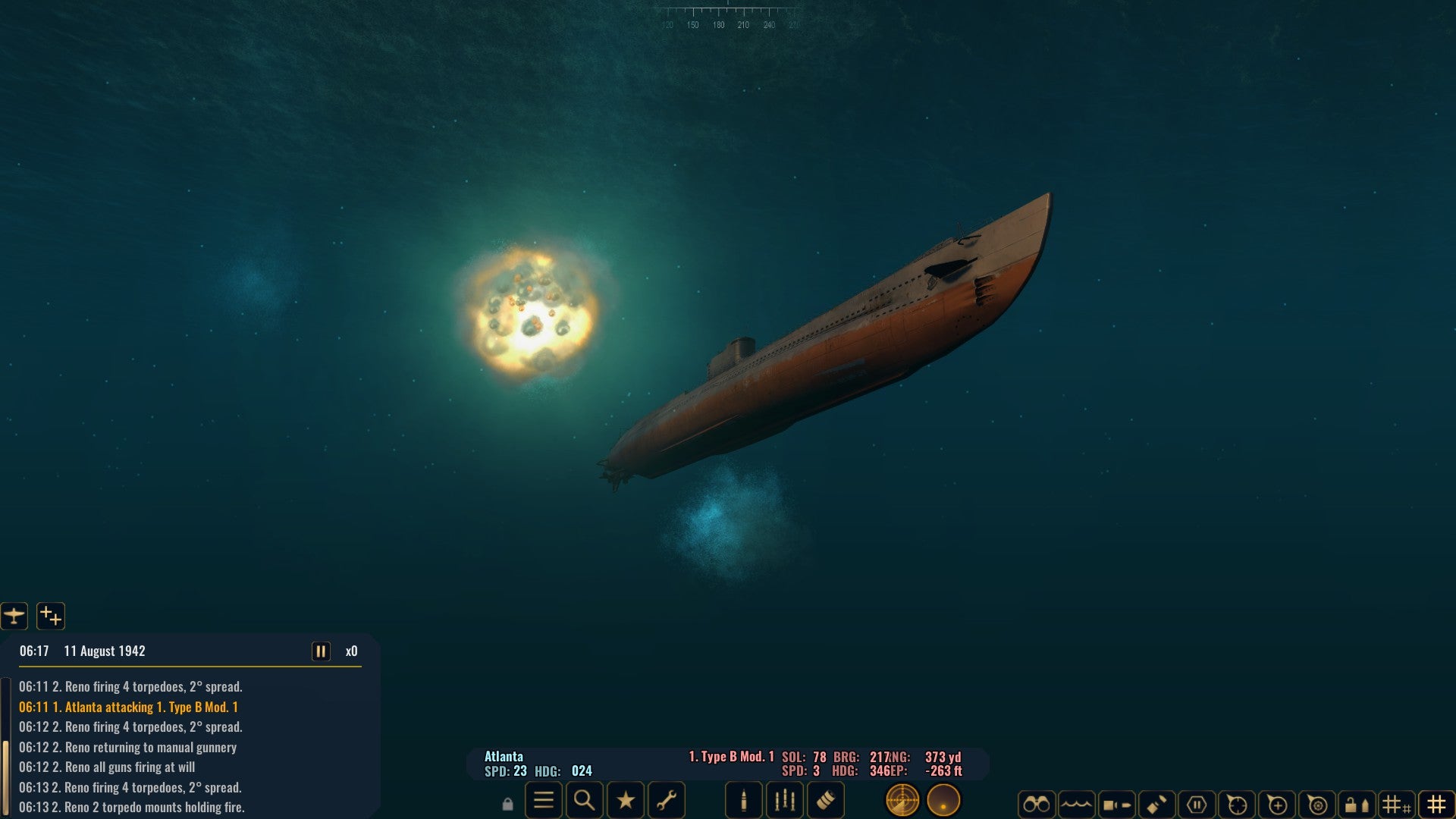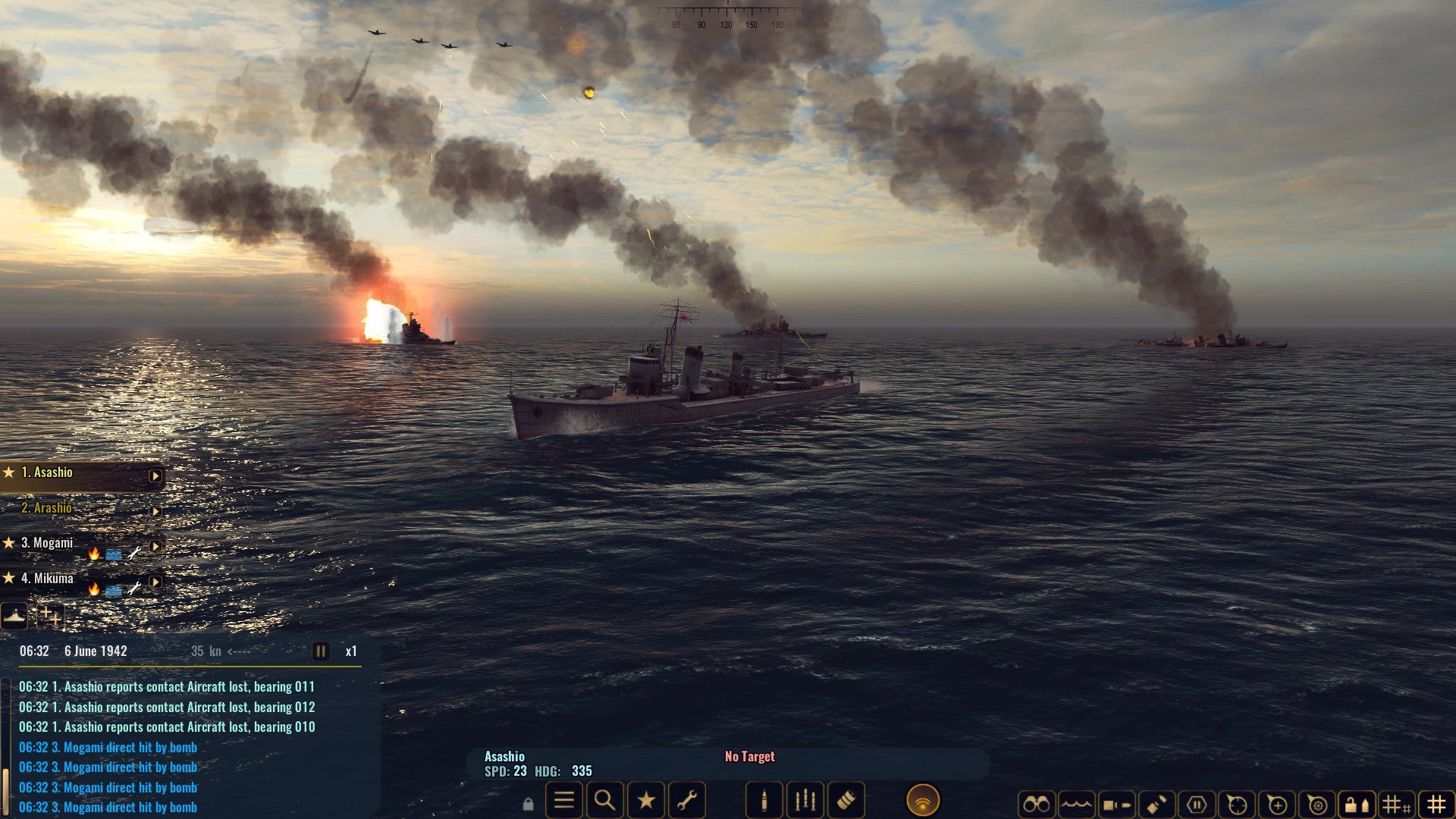
I’ve hinted a few times at my dislike of naval antics in strategy games. Since Strategic Mind set me off on a World War 2 kick, this week seemed like a good time to resolve this by picking out a dedicated seaborne war game and making a sincere effort to get over myself.
It is time to declare War On The Sea. And thus it is that I gave the order to dive to crush depth with oh wait, no this is a destroyer what have I done.
Killerfish Games may not be a household name, but they established a solid pedigree in marine warfare games with Cold Waters and Atlantic Fleet. War On The Sea is their latest, and it’s something of a sideways step in terms of design. You control either the US or Imperial Japanese navies during their war over the south pacific, establishing naval and airbases at key points in the region and using them to pump out and service real ships as you see fit. You have full control of a strategic layer, in which command points are used to summon forces that you then send around the map to fight enemy ships and ferry vital troops and supplies to land at hostile ports.
Points are gained for sinking ships, and lost forever if your own hit the seabed, making each victory feel significant, and every loss a real injury, especially early on. Each week your major ports are resupplied with troops, oil, engineering tools and generic ‘supply’ needed to maintain armies, and all this must be shipped to smaller ports and airfields, or those you’re fighting over or have just conquered and need to rebuild. Naturally this means spending precious command points on cargo vessels and whatever escorts you prefer (you can risk going without of course, but it only takes one scout plane to spot them and tell a submarine about it), so each port costs a big upfront and ongoing investment.

But if you can hold them, gosh they’re handy. The opening contest is near inevitably about the central Guadalcanal, but there’s nothing to stop a US player from building a staging point in Rennel Island first, then using planes to scout and submarines to block and harass the Japanese from the centre, while their fleets take advantage of the dramatically shorter route to drydock to rearm and repair. Or perhaps you’ll downplay the East, and attempt a buildup and surprise invasion from Port Moresby in New Guinea.
It’s this open, two-layer structure that originally tempted me. Submarine games in particular tend to have somewhat dynamic campaigns, but something about the sea suggests that total strategic freedom is a natural fit. It’s all water, right? There’s an obvious limit to where you can send your land armies, and thus where the fights can happen, but the sea is a free for all once you’re no longer reliant on the wind.
“There’s an obvious limit to where you can send your land armies, but the sea is a free for all once you’re no longer reliant on the wind.”
The second part of that structure is the battles themselves. Like X-COM or JA2 or Achtung Panzer, when fighting forces meet, they duke it out in a local battlefield under your total control. This takes the game away from the abstraction of numbers and specifications that often puts me off an oceanic war. Sure, I might have arranged my fleet poorly for this fight, but if I can sail the ship myself and time my own depth charges, I’ll get some satisfaction out of avenging my oil tanker when I watch its killer’s engines grind to a halt, and hear the terrible groaning of its cracked hull as the precious air abandons its crew. Christ, what a horrible way to go.
War On The Sea also boasts a fairly equal representation of ships and boats (aircraft are secondary but still vital, and a solid bombing/aerial torpedo run on a carrier is a sweet, sweet hit of fiery command points), and the control it gives you of your own forces means you can experiment with ship roles and fleet compositions.
This latter point is another reason I historically bounce off naval wars. The terminology. Modern warfare is complicated, and sailing is already a jargonous affair before you bring combat into it. If you’re going for even a semi-realistic naval wargame, you’ll have to face that barrier somehow. Typically, wargames and sims assume that the player already knows the basics about ship classes, gun calibres, navigation and so on. While I like to half-joke that nobody really knows what a cruiser or frigate is, that’s not an unreasonable approach for a niche interest. But it does sort of paint your game into a corner, especially if you expect a player to build a fleet from scratch. I’ve always found these games an uphill battle.

Let’s be clear: this is a me thing. I’m no stranger to detail – I spend more time organising and admiring my Jagged Alliance 2 1.13 armory than I do using it, and each of my X-Piratez has a dozen weapon types on her kill sheet. But when it comes to seafights, the differences just don’t sink in.
I bang on about all this because accessibility is a big strength of War On The Sea. The tutorials are succinct and the open structure gives room for errors, inefficiency, and the occasional foolish risk to learn from without losing everything. If you’re sailing into a losing battle you’ll usually know it before it’s hopeless, and so can pull out and come back another day with a better ship (repairs take time, but once fixed, you can send back an unwanted vessel for a full command point refund at any major port).
The technical details of fighting are pared down too, and gunnery can take care of itself to keep a heavy carrier busy while you steer a secret submarine up its propellor. It does come at some inevitable cost, though, and hardcore simulation fans will find its level of detail wanting. Even manual firing is simply clicking a point on the map rather than calculating headings and speeds (automatic fire does improve as the AI calculates a firing solution, which is affected by visibility and detection technology as you’d expect), meaning you can sort of eyeball it, letting your crew pound constantly with the smaller guns while you watch the map and fire the big cannons yourself.

It’s a compromise. A little bit like Strategic Mind, War On The Sea feels like a mid-level degree of simulation. No one element of it dramatically stands out, nor is depicted in particular detail. But it would feel unfair to give it a hard time for this. Compromises were clearly necessary somewhere in the design to get all its parts to cohere without one or the other taking over. Model torpedo calibration fully and it’d become a game in its own right, diminishing the surface wars and strategic planning. Go in hard on more detailed supply systems and you’d spend the whole time supervising cargo runs. Controlling each plane is possible but generally best left to the AI, and if it were any other way you’d surely feel forced to micromanage every flight to get results, making carrier battles impossible.
That said, it does have some weaknesses that ought to be fixed up. I’ve had fleets glitch from place to place on the map, AI ships have an embarrassing habit of colliding (by default they warp through each other. Switching collisions on is an option in the menu but they do it far too often to overlook), and there are fiddly issues with secondary guns sometimes firing on their own or torpedos not launching for unclear reasons.
The retreat system starts a timer, often several minutes long, which leads to awkward situations where nothing is happening but you still have to do nothing for three minutes before you can exit, or where you’re allowed to retreat while still under fire. I shouldn’t complain about the latter, since it’s saved me a couple of ships, but changing it would perhaps highlight the real issue, which is that the pacing of battles can be a real slog. A prolonged shootout might be realistic, but for every handful of tense and satisfying sinkfests, there’s an occasional attritional standoff I wish I could hurry along, or include the submarine from a nearby fleet that didn’t quite spawn into the map.
In truth, I don’t think I’m exactly in love with War On The Sea. For all my dull-witted moaning about how complicated and demanding its genre mates can be, part of me wants it to be more like Silent Hunter, or Killerfish’s own Cold Waters, with their more advanced targeting, stealth, and gunnery systems. But then another part keeps eyeing up the arcadey Crash Dive 2, so perhaps I’ve lost the war, and become a person who just likes naval warfare now. Killerfish have been patching the game steadily since its release, too, and there’s already a modest modding community at work on a variety of substantial tweaks. War On The Sea is doing something interesting, and though its flaws are a little too grating to entirely forgive, it feels like a good place for a landlubber to start.
